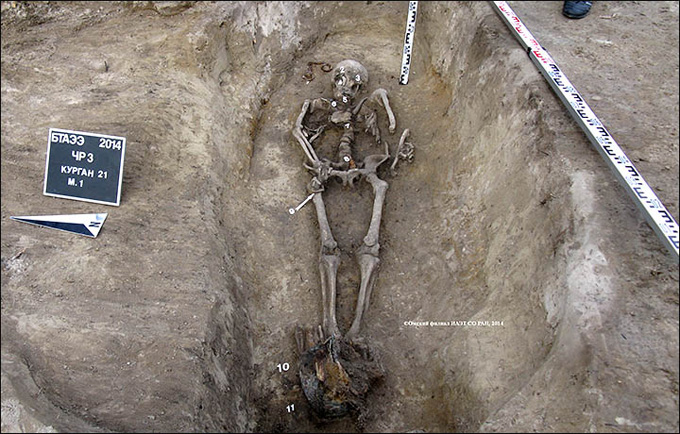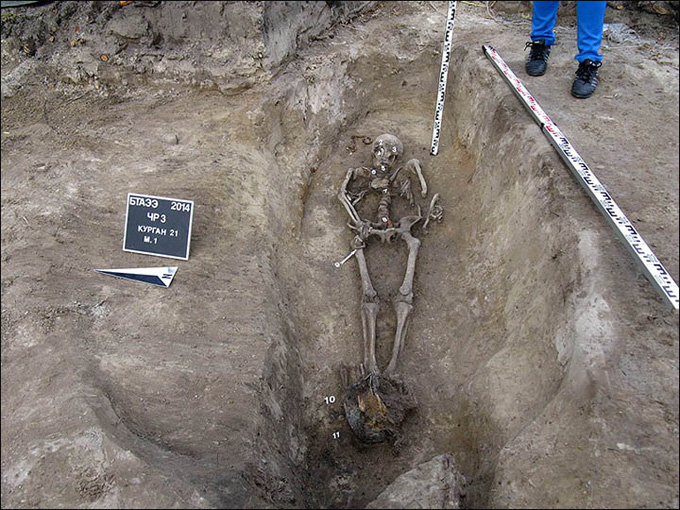Mighty Siberian hero warrior reveals his secrets from almost 1,000 years ago
Source: siberiantimes.com
First exclusive pictures inside the grave of ’giant’ warlord horseman who held sway in the 11th century but lost his left arm in his final battle.
A milestone discovery’. Picture: Institute of Archeology and Ethnography, Siberian branch of Russian Academy of Sciences
The remains of the fearsome warrior - who towered some 25 centimetres over his peers - were unearthed by archeologists near Omsk in an ancient burial mound. Experts are intrigued by his death mask and the elaborate nature of his grave which indicates his importance.
Nicknamed ’Bogatyr’ or ’Great Warrior’, he is believed to have been trained in combat since childhood. He was buried with the massive fang of a bear embedded in his nose, seen as a sign of his strength and power.
A decorated mirror - a bronze plate - lay on his chest, inside a birch bark cover. The mirror was evidently a tool to communicate with the gods.
In the grave, too, were 25 war arrows - which are still sharp today - and bronze tools.
Archeologist Mikhail Korusenko who led the expedition to the Muromtsevsky district of Omsk region told The Siberian Times the find came as his team were about to complete fifth season of work.
’We had almost finished our research and suddenly this warrior decided to meet with us,’ he said, calling the discovery a ’milestone’ and a ’sensational find’.
The pictures of the skeleton, shown here, were taken at the burial site. The image shows how archeologists believe warriors such as this ’Bogatyr’ looked at this time. His death mask originally comprising fabric included caskets made of birch bark covering the eye sockets and mouth.
Inside the caskets were metal figurines of fish with their heads broken off.
By his feet lay a bronze cauldron with the remains of food to nourish him in the afterlife.

The death mask, with number 4 marking the bear’s fang, and numbers 2 and 4 showing metal fish figurines with broken-off heads that were covering the warrior’s eye sockets. Picture: Institute of Archeology and Ethnography, Siberian branch of Russian Academy of Sciences
Close by were remains of leather and fur, perhaps part of his costume or from the quiver decorations on his arrows.
’We found 25 arrowheads - armour-piercing and diamond shaped, made from metal and bone,’ said the academic, a candidate of historical sciences, from the Omsk branch of the Institute of Archeology and Ethnography of the Siberian Branch of the Russian Academy of Sciences.
’Some of them were clearly of military purpose. Behind his skull we found a ringed bridle’ - a sign that the warrior was an accomplished horseman.
’It is interesting that the fish figures were cast as one, and then broken in two. It was an intentional action, definitely. Perhaps, it had some religious importance. Then, next to his nose was the fang of big predator, a bear, this beast being traditionally associated with strength, power and warriors.’
’Our warrior was killed in the battle. His left arm was severed in battle and placed near the body, and his shoulder was broken. But he was buried according to ritual which means he was a respected person. All the elements of the ritual give us an opportunity to discover historical and political conditions of the epoch the warrior lived in’.



Warrior’s burial clearly shows his left wrist chopped off; number 1 marks the bridle, numbers 2-5 are the details of the death facial mask, number 7 is a bronze mirror, 10-11 mark bronze cauldron and arrowheads. Below is a reconstruction of how a warrior of that culture and period of time looked like, made by A. Soloviev. Other pictures: Institute of Archeology and Ethnography, Siberian branch of Russian Academy of Sciences
He is believed to have been around the age of 40 when he died, and was a member of the indigenous Khanty and Mansi peoples, though at 180 cm in height was significantly taller than most Siberian natives of this period.
’There was a mirror on his chest, made as a metal plate. Usually such mirrors were worn as amulets, as a tool to communicate with gods.
’I am doubtful he was a shaman himself. Rather he was very important man. We called him ’Bogatyr’ (great warrior), and there is a connection with folklore.
’This man belonged to the tribes that were the ancestors of modern Khanty and Mansi peoples; usually small, these tribes had to protect their borders and often had few men of outstanding physical condition. Our man was about 180 cm tall, which was very tall for those times.

Bronze mirror was found on the warrior’s chest. Picture: Institute of Archeology and Ethnography, Siberian branch of Russian Academy of Sciences
The items found in the grave, and the remains of his lower arm and hand buried with the rest of the corpse, but severed from it, indicate this Siberian hero perished in battle.
’There is no doubt that the burial belonged to Ust-Ishim culture, the historical ancestors of modern Khanty and Mansi people,’ Mikhail Korusenko said.
’The first studies we made allow us to date the burial to approximately 11th-12th centuries AD. It is a truly unique find which would allow us to fill pages about not only the cultural, but the military history of this part of the region, as we know very little about this particular period of time.’






















